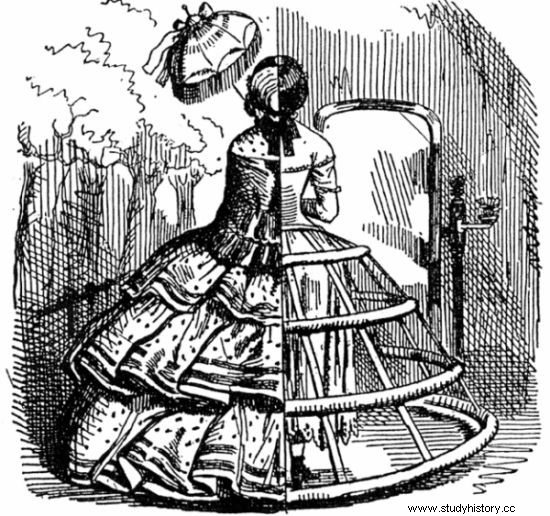In 1882, Oskar Wilde lamented:From the sixteenth century to the present day, no torture has been invented that is not imposed on our girls, nor can women endure in the name of a mindless and monstrous Fashion. He was right. His era gave birth to the first "fashion victims". And it is quite literal.
Illness and death from arsenic poisoning are just one of the ways in which you could become a 19th century "fashion victim" (click to read an article on this topic!).
Another is getting burned alive in the most fashionable crinoline gown. It was a type of skirt made of fabric with metal hoops or hairline, popular from around 1850.
Top of elegance
Undoubtedly elegant, the crinolines, however, were extremely impractical due to the amount of space they occupied. Ladies could not sit in armchairs, walk through doors, walk in crowded places, travel by train or public transport, or even kneel down. And the gentlemen complained that they could no longer give their companions their arm during a walk because the dress was in the way.

The crinolines were not only deadly but also really bulky!
Not only that, on windy days the crinoline was easily blown upwards. But the worst part was the ignition hazard - it's hardly surprising when the lady couldn't even see where the hem of her dress was.
Hot Fashion
A French actress died when her dress burst into flames. At that time, theaters used gas and limestone lighting, i.e. open fire.
A German aristocrat caught with a cigarette tried to hide it under her skirt, but the crinoline caught fire and the unfortunate smoker burned alive. Two of Oskar Wilde's half-sisters were killed by crinolines at a party:one dress caught fire, the other tried to save her.
Thousands of victims
In just a decade, between the late 1850s and 1860s, in England burned as many as 3,000 women from their own dresses.

Cross-section of a crinoline. A truly devilish invention
There were also ballerinas among them, whose muslin tutu was engaged in fire from gas lamps. The delicate, light tutu gave ballerinas an ethereal appearance, perfect for staging magical stories about fairies and ghosts, as well as garlands and shawls.
Girls dressed like this burned like torches. Such cases have been referred to as the "ballerina holocaust." They could, of course, wear fireproof fabrics, but most found them too ugly. Anyway, they lived in the Victorian era. If they hadn't been killed by the crinoline, corsets or arsenic paint would have done so…
Bibliography:
- Bales Kortsch Ch., Dress Culture in Late Victorian Women's Fiction. Literacy, Textiles, and Activism , Ashgate Publishing Limited, 2009.
- Chrisp, P. A History of Fashion and Costume. The Victorian Age , Bailey Publishing Associates Ltd., 2005.
- Paterson M., A Brief History of Life in Victorian Britain , Running Press Book Publishers, 2008.
- Steele P., A History of Fashion and Costume. The Nineteenth Century , Bailey Publishing Associates Ltd., 2005.
